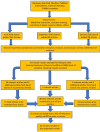The Systemic Effects of Blood Flow Restriction Training: A Systematic Review
- PMID: 34386277
- PMCID: PMC8329318
- DOI: 10.26603/001c.25791
The Systemic Effects of Blood Flow Restriction Training: A Systematic Review
Abstract
Background: Blood flow restriction (BFR) training has been reported to have significant benefits on local skeletal muscle including increasing local muscle mass, strength, and endurance while exercising with lower resistance. As a result, patients unable to perform traditional resistance training may benefit from this technique. However, it is unclear what effects BFR may have on other body systems, such as the cardiovascular and pulmonary systems. It is important to explore the systemic effects of BFR training to ensure it is safe for use in physical therapy.
Purpose: The purpose of this study was to systematically review the systemic effects of blood flow restriction training when combined with exercise intervention.
Study design: Systematic review.
Methods: Three literature searches were performed: June 2019, September 2019, and January 2020; using MedLine, ScienceDirect, PubMed, Cochrane Reviews and CINAHL Complete. Inclusion criteria included: at least one outcome measure addressing a cardiovascular, endocrinological, systemic or proximal musculoskeletal, or psychosocial outcome, use of clinically available blood flow restriction equipment, use of either resistance or aerobic training in combination with BFR, and use of quantitative measures. Exclusion criteria for articles included only measuring local or distal musculoskeletal changes due to BFR training, examining only passive BFR or ischemic preconditioning, articles not originating from a scholarly peer-reviewed journal, CEBM level of evidence less than two, or PEDro score less than four. Articles included in this review were analyzed with the CEBM levels of evidence hierarchy and PEDro scale.
Results: Thirty-five articles were included in the review. PEDro scores ranged between 4 and 8, and had CEBM levels of evidence of 1 and 2. Common systems studied included cardiovascular, musculoskeletal, endocrine, and psychosocial. This review found positive or neutral effects of blood flow restriction training on cardiovascular, endocrinological, musculoskeletal, and psychosocial outcomes.
Conclusions: Although BFR prescription parameters and exercise interventions varied, the majority of included articles reported BFR training to produce favorable or non-detrimental effects to the cardiovascular, endocrine, and musculoskeletal systems. This review also found mixed effects on psychosocial outcomes when using BFR. Additionally, this review found no detrimental outcomes directly attributed to blood flow restriction training on the test subjects or outcomes tested. Thus, BFR training may be an effective intervention for patient populations that are unable to perform traditional exercise training with positive effects other than traditional distal muscle hypertrophy and strength and without significant drawbacks to the individual.
Level of evidence: 1b.
Keywords: blood flow restriction; cardiovascular; endocrine; musculoskeletal; psychosocial; systemic effects.
Conflict of interest statement
The authors of this systematic review report no conflicts of interest, financial or otherwise, in the production of this manuscript.
Figures
References
-
- Effects of walking with blood flow restriction on limb venous compliance in elderly subjects. Iida Haruko, Nakajima Toshiaki, Kurano Miwa, Yasuda Tomohiro, Sakamaki Mikako, Sato Yoshiaki, Yamasoba Tatsuya, Abe Takashi. Jul 28;2011 Clin Physiol Funct Imaging. 31(6):472–476. doi: 10.1111/j.1475-097x.2011.01044.x. doi: 10.1111/j.1475-097x.2011.01044.x. - DOI - DOI - PubMed
-
- Very-low-load resistance exercise in the upper body with and without blood flow restriction: cardiovascular outcomes. Mouser J. Grant, Mattocks Kevin T., Dankel Scott J., Buckner Samuel L., Jessee Matthew B., Bell Zachary W., Abe Takashi, Loenneke Jeremy P. 2018Applied Physiology, Nutrition, and Metabolism. 44(3):288–292. doi: 10.1139/apnm-2018-0325. doi: 10.1139/apnm-2018-0325. - DOI - DOI - PubMed
-
- Oxford Centre for Evidence-Based Medicine: Levels of Evidence. [2021-3-22]. https://www.bcit.ca/files/library/pdf/bcit-ama_citation_guide.pdf
LinkOut - more resources
Full Text Sources
Research Materials

